#aztec art
Text


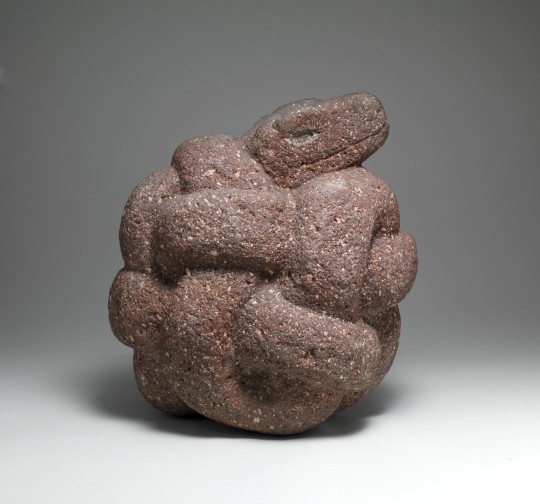
Happy Monday! Here are three Aztec stone snakes for you. The greenish one (13th-16th century) is from the Cleveland Museum of Art and the other two (15th-early 16th century) are from the Metropolitan Museum of Art, two open access collections on JSTOR.
3K notes
·
View notes
Text

Earthquake Reveals Aztec Snakehead Beneath Mexico City
Researchers are conserving a rare snakehead from the Aztecs that still retains its painted colors from hundreds of years ago.
An earthquake last year revealed a big surprise beneath a law school in modern-day Mexico City: a giant, colorful snakehead from the Aztec Empire.
The snakehead dates back more than 500 years, to when the Aztecs controlled the area, which at the time was part of the flourishing capital of Tenochtitlan. The sculpture was discovered after a magnitude-7.6 earthquake struck Mexico City on Sept. 19, 2022; the seismic event caused damage and changes in the topography, revealing the snakehead beneath a building that was part of a law school at the National Autonomous University of Mexico, Mexico's National Institute of Anthropology and History (INAH) said in a Spanish-language statement.
The Aztecs built temples and pyramids and worshipped a number of deities, including Quetzalcoatl, who was often depicted as a snake. However, it's unclear if this sculpture depicts him, the archaeologists said.
The sculpted snake is 5.9 feet (1.8 meters) long, 2.8 feet (0.85 m) wide and 3.3 feet (1 m) high, and it weighs about 1.3 tons (1.2 metric tons), the INAH said. Several colors — including red, blue, black and white — are preserved on the sculpture.

Color was preserved on about 80% of the sculpture's surface. To keep it preserved, an INAH team lifted the snakehead out of the ground with a crane and constructed a humidity chamber around the sculpture. This chamber allows the sculpture to lose humidity gradually, with its color being preserved, María Barajas Rocha, a conservationist with the INAH who worked extensively on the sculpture, said in the statement.
While other snakehead sculptures have been found at Tenochtitlan, this one is particularly important for its preserved colors, said Erika Robles Cortés, an archaeologist with the INAH.

"Thanks to the context in which this piece was discovered, but above all, thanks to the stupendous intervention of the restorers-conservators led by Maria Barajas, it has been possible to stabilize the colors for its preservation in almost all the sculpture, which is extremely important, because the colors have helped us to conceive pre-Hispanic art from another perspective," Robles Cortés told Live Science in an email.
The sculpture's "sheer size is impressive, as well as its artistry," but the survival of the colors is remarkable, said Frances Berdan, a professor emeritus of anthropology at California State University, San Bernardino who was not involved with the excavation. "The survival of black, white, red, yellow, and blue paints is particularly interesting — one gains a good image of the visual impact of such sculptures as they were arrayed about the city center," Berdan said in an email.

In addition to its preserved colors, the snakehead's size is notable, said Bertrand Lobjois, an associate professor of humanities at the University of Monterrey in Mexico who is not involved in the excavation. The "first time I saw this serpent head, I was dazzled by its dimensions," he said in an email.
Lobjois also praised the conservation work that allowed the colors to survive, noting that "the conservation process allows us to appreciate the naturalistic approach of figuration" the Aztec artists used.
This work is ongoing and will continue at the site into next year.
By Owen Jarus.
#Earthquake Reveals Aztec Snakehead Beneath Mexico City#National Autonomous University of Mexico#Quetzalcoatl#sculpture#stone sculpture#ancient artifacts#archeology#archeolgst#history#history news#ancient history#ancient culture#ancient civilizations#aztec culture#aztec history#aztec mythology#aztec gods#aztec empire#aztec art
521 notes
·
View notes
Text
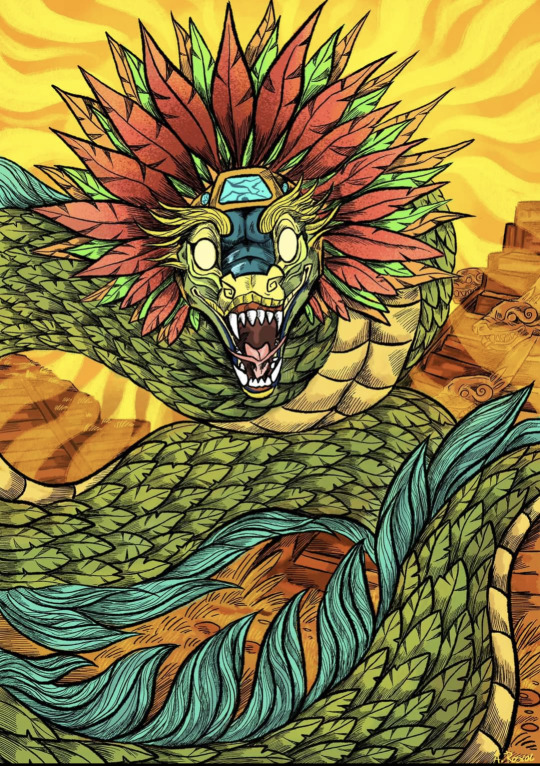

Quetzalcoatl and Huehuecoyotl
Working on drawing more Aztec gods, probably drawing Coatlicue and Xochiquetzal soon.
#mesoamerican#mexican#mexica#huehuecoyotl#Quetzalcoatl#coyote#gods#aztec#aztec art#aztec gods#ancient gods#illustration
410 notes
·
View notes
Text
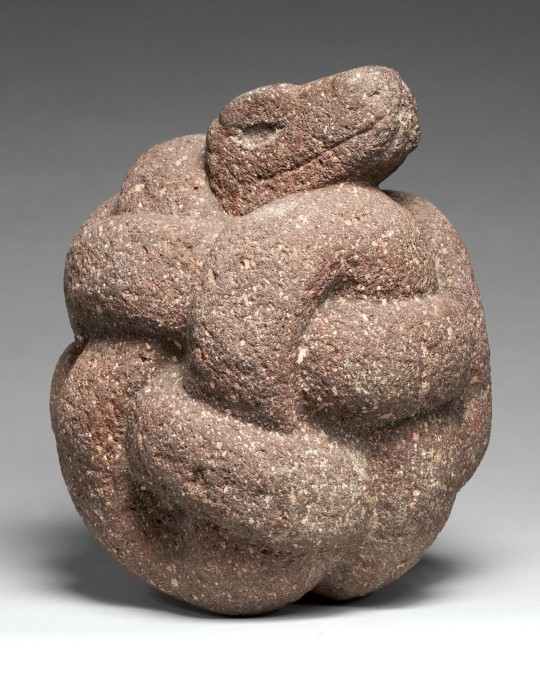
Coiled serpent - Aztec, 15 century
120 notes
·
View notes
Text

Statuettes - Templo Mayor Museum, Mexico City, 2014
#original photographers#photographers on tumblr#travel#mexico#aztec art#mask#ancient art#art#statuette#aztec culture
21 notes
·
View notes
Text


Top- Saiho Temple wooden sculpture of the monk Baozhi, 12th century Japanese
Bottom- Fragment of an Anthropomorphic Brazier, 14th century Aztec
177 notes
·
View notes
Text
#Caturday:

Reclining Jaguar, c. 1400-1521
Aztec artist, Mexico
Volcanic stone
From Brooklyn Museum’s “Climate in Crisis: Environmental Change in the Indigenous Americas” exhibition
“This reclining jaguar is an excellent example of Aztec naturalistic sculpture. Every part of the animal is carefully rendered, including the underside, where the paw pads are carved in low relief. To the Aztec, the jaguar symbolized power, courage, and a warlike attitude. Some of the highest-ranking warriors were called jaguar warriors, and rulers associated themselves with Tezcatlipoca, a deity who sometimes assumed the guise of this powerful predator.”
#animals in art#jaguar#Caturday#Mesoamerican art#Indigenous art#Aztec art#Mexican art#pre conquest art#sculpture#stone#Brooklyn Museum#exhibition#museum visit
31 notes
·
View notes
Text
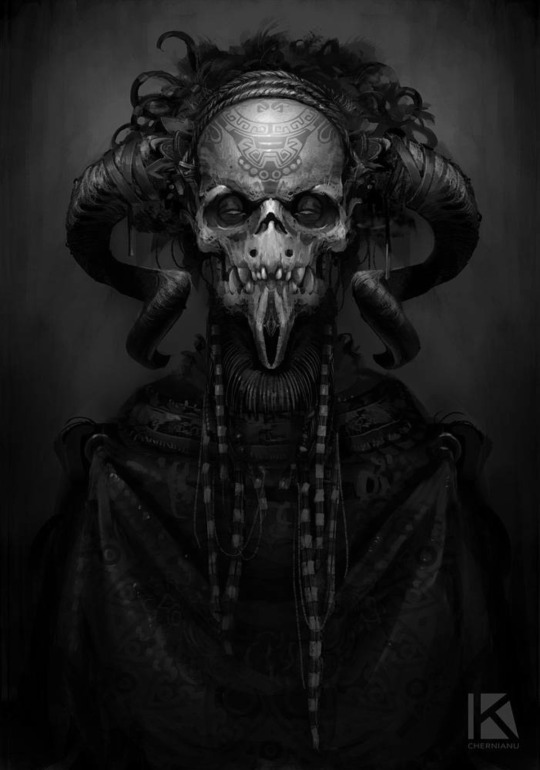
Kostya-PingWIN
10 notes
·
View notes
Text
life-death mediator

quality crop, plus simple

liked my paper artwork so lined it as a digital art practice, still suck at it
#art#ethnic#ethnic art#digital art#oc#aztec#aztec art#a slightest resemblance#blue#artists on tumblr#is it sort of#slight nudity#graphic art
19 notes
·
View notes
Text


The Aztec Death Whistle ‘The Most Terrifying Sound in the World’
For those who want to celebrate Halloween like it’s 1399: Scientists are sending shivers down the internet’s collective spine by recreating an ancient “Aztec Death Whistle” that’s said to emit the “most terrifying sound in the world.”
The macabre kazoo is detailed in a new video produced by the Action Lab, a group of proud internet nerds who specialize in mind-bending experiments.
“The sound that the death whistle makes innately strikes fear into your heart,” intones presenter James J. Orgill in the clip while holding a 3D-printed version of the instrument.
The Brigham Young University engineering grad then plays an audio clip of the scream machine, which evokes a bloodcurdling, bansheelike shriek resembling a sound effect from a haunted house attraction. (We dare you not to jump!)
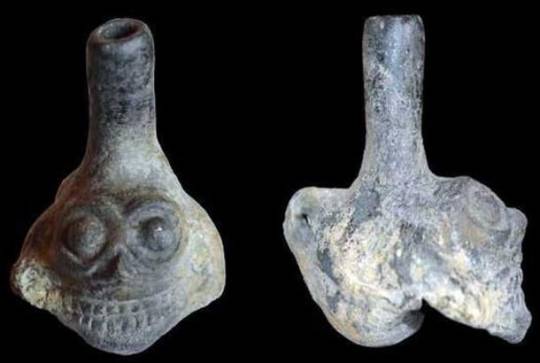
Orgill points out that this is not a “human scream” but rather the sound emitted by the replica of a skull-shaped artifact originally discovered in Mexico City in 1999 by archaeologists.
It was reportedly found clutched in the hand of a headless skeleton in a temple dedicated to the wind god Ehecatl — one of many sites where the Aztecs conducted human sacrifices.
Initially thinking it was a toy, per Orgill, scientists didn’t blow into it until 15 years later, whereupon it emitted a terrifying sound.
“‘It was a startling discovery because it sounded like a screaming human,” said the burgeoning YouTube star, who dubbed it the “most terrifying sound in the world.”


The Aztecs were able to create this nightmarish noise by modeling the death whistle after the human larynx.
When the user blows into the instrument, the wind divides in two, producing oscillating sound waves that bounce around a large chamber before leaving via a second hole.
While the purpose of the instrument remains unclear, experts have several theories, with some believing this fright flute was used to scare enemies in battle.
Others postulate that the whistle was a defense talisman used to ward off evil spirits during a sacrificial victim’s journey to the afterlife.
In order to resurrect this symphony of screams for our listening “pleasure,” Orgill blew into different Tim Burton-esque whistles that were 3D-printed by US tech firm HeyGears.
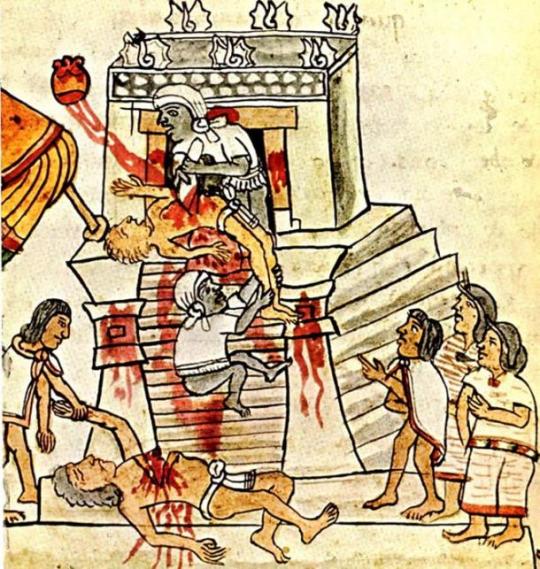


All told, they made the raptor larynx from “Jurassic Park” sound like a kazoo.
No 3D printer, no problem: Interested parties can buy their death whistles on Amazon, which offers duplicates made of materials ranging from resin to carbon fiber.
Many advertise how closely their decibels match that of the most bone-chilling human screams.
By Ben Cost.
#Aztec Death Whistle#The Aztec Death Whistle ‘The Most Terrifying Sound in the World’#Tlatelolco#mexico city#the wind god Ehecatl#ancient artifacts#archeology#archeolgst#history#history news#ancient history#ancient culture#ancient civilizations#aztecs#aztec history#aztec mythology#aztec culture#aztec gods#aztec empire#aztec art
196 notes
·
View notes
Text

Hanging out, chillin'- if you want to send me an ask I'll probably answer it tonight
77 notes
·
View notes
Text

close up of one of the aztec coaster set
10 notes
·
View notes
Text

Thrilled tourists - Teotihuacán, 2014
#picoftheday#travel#mexico#original photographers#photographers on tumblr#street photography#streetphoto color#tourists#ancient architecture#aztec culture#aztec art#ancient temple#architecture#art#photooftheday
12 notes
·
View notes
Text

Jaguar Warrior Helmet 🐆🩸
27 notes
·
View notes
Text
Picture books with an international focus
A mom came in today with an astounding heap of children's books. Every one was "presumed lost", so her kids had been enjoying them for quite a while. She wanted to see if the returned pile cleared the card they had been checked out on, but to my amazement, it didn't. She still had about a Benjamin in overdue fines on her card, so we checked her daughter's, which had almost as much in overdue fines! Then she asked me to check her husband's card, where we found about $20 in overdue fines, and she decided to just pay that one. Wow. It reminded me of the women who used to come into Lord & Taylor's handbag department: when one of their cards failed, they'd pull out another until they found one that wasn't maxed out. You'd think if one of your credit cards were maxed out, that would be a warning to stop shopping, but apparently not. At least in this scenario, it's about kids reading books - which I ALWAYS wish to encourage. And she apparently does, too - she returned with another HUGE stack of books to take out on her husband's now-clear card.
In her stack, I found three intriguing items: Reza Dalvand's Mrs. Bibi's Elephant, Minfong Ho and Saphan Ros's The Two Brothers, and Duncan Tonatiuh's The Princess and the Warrior. I'm delighted that she's teaching her children to read about other cultures!

Mrs. Bibi's Elephant is adorable: a simple story with a surprisingly cryptic ending. My favorite page showed Mrs. Bibi having tea with her elephant, the teacup balanced perfectly on the end of its trunk. The story pits people who have and love pets against people who like things (chandeliers, jewelry, the stock market). The town's children, who love the elephant, oppose the town's adults, who don't care about pets. A delightfully furry (or scaly, or feathered) Marxist message from Iranian illustrator Reza Dalvand.

I thought I would write about Ho and Ros's The Two Brothers, but there's not much to say about this one, unless you're simply into Cambodian stories. It's a classic fairy tale of the 1001 Nights style; unfortunately, the artwork is pleasing but unremarkable. I much preferred the startling art of Duncan Tonatiuh's The Princess and the Warrior: A Tale of Two Volcanoes. No fable with a lesson here: the princess and the warrior's adventure is remarkable and traditional, but bittersweet and unresolved. The art really sets this story apart. Although I'm sure it exists elsewhere, this is the first time I've seen an artist employ precisely the style seen on artifacts, tombs and temples of the Aztecs, placing them in action sequences like cartoon characters. It's gorgeous, unusual, and faithful to Aztec art.

#childrens books#children's book art#mrs. bibi's elephant#reza dalvand#the two brothers#cambodian stories#minfong ho and sapham ros#the princess and the warrior#duncan tonatiuh#aztec stories#aztec art#1001 nightts#iranian children's book art
2 notes
·
View notes
Text
For Butterfly Education & Awareness Day:
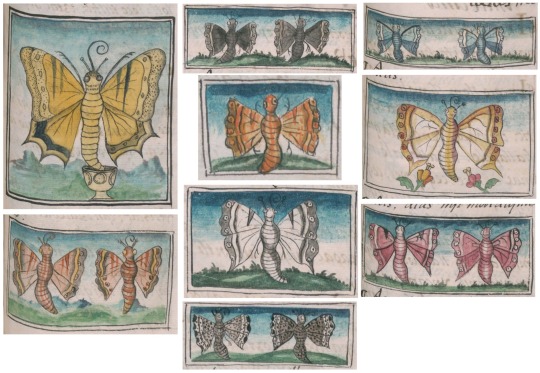
Composite image collecting the illustrations of papalotl (butterflies) in Book 11 of the Florentine Codex ("Earthly Things," the volume dedicated primarily to Aztec natural history). All illustrations were done by Indigenous Nahua artists; the 12-volume encyclopedia was compiled by Spanish Franciscan friar Bernardino de Sahagún and completed c. 1577.
See in the images embedded in the original text here: https://www.loc.gov/resource/gdcwdl.wdl_10622/?sp=6&st=gallery
#animals in art#indigenous art#Mesoamerican art#Florentine Codex#colonial art#16th century art#illustration#codex#illuminated manuscript#book art#butterfly#butterflies#insects#natural history art#Aztec art#Nahua art#Bernardino de Sahagún#Butterfly Education and Awareness Day#Butterfly Day#animal holiday
45 notes
·
View notes